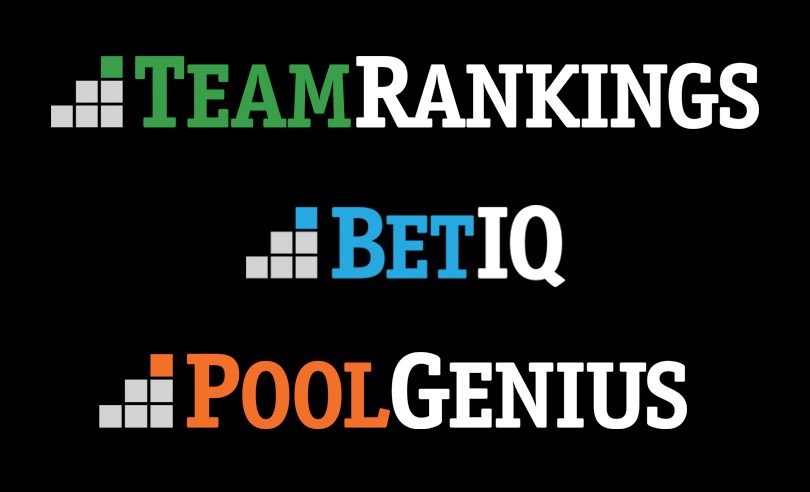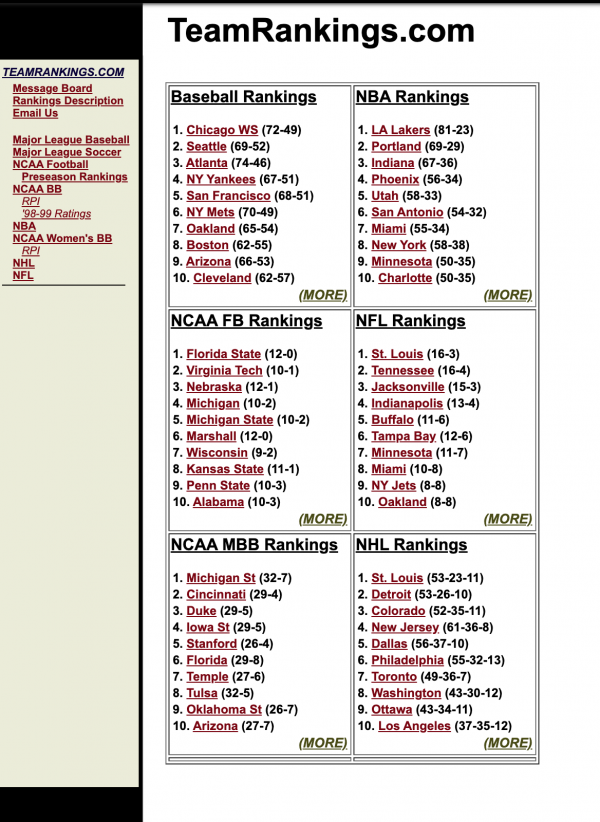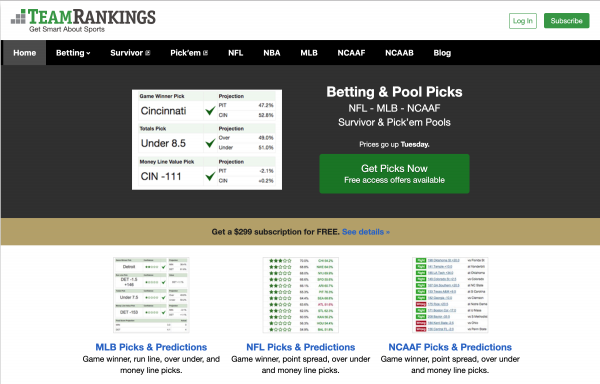Introducing BetIQ and PoolGenius, Two New Brands From TeamRankings
August 18, 2022 - by Tom Federico

For a company that tends to prioritize product building over snazzy marketing, we recently took a pretty significant step in the branding department.
We have decided to move from operating a single brand (TeamRankings) to operating a network of multiple brands (and in the future, a portfolio of different websites and mobile apps).
We’ve published another blog post that explains the implications of this transition for our visitors and subscribers. But for the curious, we also wanted to explain why we’re making this change.
In short, we’re finally addressing a branding challenge that has plagued us for years.
We Had One Brand. Now We Have Three.
First, a quick recap of what we’ve done so far.
For over 20 years, TeamRankings has provided data and tools to sports fans, bettors, and pool players. We are now targeting those latter two audiences—bettors and pool players—with distinct brands.
As a result, we now own and operate three distinct brands:
- TeamRankings for statistically-minded league and team fans.
- BetIQ for sports bettors looking to make the most informed bets.
- PoolGenius for pool players serious about maximizing their edge.
We may introduce more brands in the years ahead. For the foreseeable future, though (let’s say the next 12-18 months), we plan to focus on building out and improving these three brands.
The Backstory
Here’s the context behind the branding and business challenges that led to this transition.
When original TeamRankings founder Mike Greenfield launched the first version of TeamRankings.com at the turn of the (21st) century, his primary motivation came from being a passionate team fan.
Mike was in his senior year at Stanford University, and he thought that based on an objective view of the stats, both the AP Poll and Coaches Poll were criminally underrating the Cardinal basketball team.
So Mike set out to prove the sports “experts” wrong by developing his own data-driven rankings of teams. He also wanted to learn about coding and web technology. Figuring out how to publish his rankings on the Internet—and to get them to update daily, in a fully automated way—seemed like a great learning project.
Hence TeamRankings.com was born. (Kind of wild that in 1999, that domain name was available for $9.99.)
Here’s a snapshot of the site from August 2000 from the always amazing Wayback Machine, back when the St. Louis Rams were coming off their Super Bowl winning season…

From Passion Project To Business
In his free time over the next few years, Mike continued to build out the site. He added more sports and started tinkering with predictive modeling, a budding interest of his. As time passed, he noticed a few things:
- Traffic was growing.
As Mike continued to add unique and sophisticated data (by early 2000’s standards, at least), traffic to the site was growing steadily, despite him not spending a penny on marketing or advertising. - Predictions were popular.
Some of the site’s most popular pages were the ones that showed Mike’s computer-calculated daily game predictions for different sports. Those predictions were derived from Mike’s homemade predictive ratings as well as from another more sophisticated model he had built. - Certain users were highly engaged.
Internet technology was in its early days back then, and Mike’s self-taught coding skills weren’t the most advanced. As a result, technical glitches that crashed the site or stopped it from updating happened fairly frequently. Before long, support emails from anxious visitors began to pile up after a glitch. These emails shared a theme: “Are the predictions are going to be back up before today’s games start?!”
These observations kicked off the transformation of “TeamRankings, the hobby site” into “TeamRankings, the business.” Sports bettors clearly seemed to be getting some value from the site. And if people were staking a bunch of money on sports—via betting, or sports pools, or fantasy leagues, etc.—then at least some of them should be willing to pay for relevant data and useful analysis tools, right? Just like how serious stock traders all pay a bunch of money for Bloomberg terminals.
Thankfully, that hypothesis proved true—enough for us to build a successful small business around it, at least. (Who wants Bloomberg’s billions anyway!)
Getting the company off the ground was tough, and we were cautious with our approach to expansion in the early days. (In retrospect, too cautious.) But our business has accelerated in recent years, and today we’re investing more than we ever have into improving our products, growing our team, and providing more value to subscribers and visitors.
The Branding Problem
Based on how our business evolved, though, we knew we faced a branding challenge. Today there are around 200,000 pages of free sports data on TeamRankings.com. Lots of sports fans use the site on a daily basis, either to see where their favorite teams stand or as a general stats resource.
However, general sports fans have not been our primary focus in recent years. That’s because we currently make most of our money by selling premium subscriptions to sports bettors and pool players.
If you visit the TeamRankings homepage today (August 2022), for instance, it’s clear that our first priority is to make you aware that we sell betting and pool picks:

We don’t even have actual rankings of teams anywhere on the homepage, which seems a wee bit odd for a site literally called “TeamRankings.” And on the flip side, the name “TeamRankings” doesn’t exactly scream “this site offers premium services to sports bettors and pool players.”
Thinking To The Future
We’ve debated how to solve this branding problem for a while. On the one hand, TeamRankings is now a 20+ year old name familiar to many people. By virtue of it being around forever and showing up in a lot of Google search results, TeamRankings has already accumulated brand awareness among gamblers and pool players.
(That awareness would be even better if we had had any sort of a social media game going over the past decade, but we’ve been absolutely pathetic in that department. We’re working on it.)
In short, plenty of people already know that TeamRankings.com sells premium services for sports betting and pools. So messing with the status quo is a risk, and forces change on our most valuable audiences: existing subscribers and visitors.
On the other hand, we’re still a small business. The number of people who have never heard of us and whom we want to reach is far, far greater than the number of people who already know about us. So we want to optimize our marketing strategies for the future.
Having to get new users and prospective subscribers to understand that “TeamRankings” offers much more than just rankings would always be an impediment to growth. For example, a person looking for advice on an NFL survivor pool may see the URL “TeamRankings.com” and not even bother visiting the site in the first place.
From a branding perspective we were effectively getting the worst of both worlds:
- Undercutting a strong, targeted brand.
TeamRankings is a fantastic name (maybe the best name) for a sports rankings site. But because of how our business evolved, we’re not exploiting that brand value to anywhere near the fullest extent. After being around for two decades, TeamRankings.com should be the site that millions of sports fans think of first when they want to see smart rankings and predictions for their favorite sport. Right now it is not. - Forcing prospective customers to figure out what we do.
If our existing brand was a sufficiently vague term (like “Apple” or “Yahoo!”) with no associated meaning in our industry, it would be easier for us to target different audience segments with a single brand. But that’s not the case. If a friend told you to visit a sports site called TeamRankings.com, you would have clear expectations of what you would find there. Our current homepage doesn’t meet those expectations. Instead, first-time visitors are forced to spend extra time understanding what TeamRankings does, assuming they have the patience to do so in the first place—and some percentage of them won’t.
Distinct User Populations
In terms of convincing us that it was time to make a change, the icing on the cake was some research into user behavior that we conducted, by analyzing our site’s traffic logs and doing some on-site testing.
In summary, we found that crossover usage of site pages that specifically targeted one of our core use cases (i.e. fan info, betting, or pools) was lower than we assumed it would be. In particular:
- Subscribers who had access to both betting-related features and pool-related features were typically much bigger consumers of just one of those two categories of features.
- When we aggressively promoted our premium subscriptions to new visitors who came to the site to look at content more indicative of being a general sports fan, those visitors converted at an extremely low rate.
Nothing is ever completely black and white when it comes to segmenting prospective customers. For example, there are surely sports bettors and fantasy/DFS players who are using the free data on TeamRankings.com for research, but who may never have any interest in subscribing to our premium services.
However, our general conclusion was that a majority of our users appeared to have a strong primary motivation for using TeamRankings.com—either for betting, or for pools, or for some other reason.
A Dose Of Contrarianism?
It’s also worth noting that the state-by-state legalization of sports betting in the U.S., kicked off by a 2018 Supreme Court ruling (thanks, SCOTUS!), has led to what can only be described as an infatuation with sports betting within the sports media and data industries.
For a profit-driven sports media business, the economic returns now possible by incessantly jamming sports betting related content down the throat of an audience may well end up being justified (in the short term, at least). However, we remain convinced that a substantial portion of U.S. sports fans do not and will never prefer to identify as “sports bettors” first, even if they place a wager here and there.
We’ve learned a lot over two decades of serving both fans and bettors, and this much is clear to us. There’s a way to speak to people who are primarily fans that occasionally bet, and a much different way to speak to people who wake up every morning excited to figure out what they’re going to bet on that day. (“Degenerates” is such a crass word, we prefer “Speculation Seekers” or “EV Enthusiasts.”)
We have a lot to offer both populations, and we now have distinct brands to optimize the messaging to each one: TeamRankings for the “fans first” group, and BetIQ for more active bettors.
One final thought here. Given the industry’s current obsession with sports betting, we think that there may be a corresponding decline of investment over the next few years in providing great information and experiences to everyday fans who simply don’t care all that much about betting. We consider that a longer-term opportunity, and as veritable dinosaurs of the Internet, we like playing the long game.
The Plan From Here
Given everything discussed above, splitting TeamRankings into a network of brands made the most sense to us. Now that our first three brands are all out in the wild, here’s our general plan for the near future:
- Increase subscriber value.
Building useful products for sports bettors (via BetIQ) and pool players (via PoolGenius) will continue to be the focus of our premium subscription business. We’re increasing our investments of time and resources into these products. (On that note, we plan to drop some job postings in the near future, but if you’re looking for a new gig and think you can help us—especially if you’re an engineer or have data science skills—feel free to shoot us an email at jobs@teamrankings.com and show us what you can do.) - Grow our audience.
At the same time, we plan to renew our focus on the “general sports fan” use case via TeamRankings. Our goal is for TeamRankings to offer a much more brand-aligned set of free features that league and team fans love, which eventually will include more sports (we hear you, NHL fans!) and personalization of the site around your favorite sports, teams, and players. If we execute our plan well, a day will come in the not too distant future when TeamRankings.com delivers all that you expect (and more) from a site of that name.
If you got this far, thanks for reading. If you have any feedback or just want to give us your two cents about this business strategy decision, feel free to drop us an email at support@teamrankings.com.
Printed from TeamRankings.com - © 2005-2024 Team Rankings, LLC. All Rights Reserved.